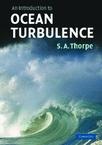An Introduction to Ocean Turbulence海洋湍流引论
出版时间:2007-11 作者:Thorpe, Stephen 页数:240
Tag标签:无
内容概要
This textbook provides an introduction to turbulent motion occurring naturally in the ocean on scales ranging from millimetres to hundreds of kilometres. It describes turbulence in the mixed boundary layers at the sea surface and seabed, turbulent motion in the density-stratified water between, and the energy sources that support and sustain ocean mixing. Little prior knowledge of physical oceanography is assumed. The text is supported by numerous figures, extensive further reading lists, and more than 50 exercises that are graded in difficulty. Detailed solutions to the exercises are available to instructors online at www.cambridge.org/9780521859486. This textbook is intended for undergraduate courses in physical oceanography, and all students interested in multidisciplinary aspects of how the ocean works, from the shoreline to the deep abyssal plains. It also forms a useful lead-in to the author's more advanced graduate textbook, The Turbulent Ocean (Cambridge University Press, 2005). 作者简介: Steve Thorpe was a Senior Scholar at Trinity College, Cambridge, where he studied mathematics and fluid mechanics, his PhD being awarded in 1966. He then spent 20 years at the UK Institute of Oceanographic Science, before being appointed Professor of Oceanography at Southampton University in 1986. He has made laboratory experiments on internal waves and turbulent mixing, and has measured and developed instrumental and analytical methods for studying waves and mixing in lakes, as well as making seagoing studies of turbulence in the boundary layers of the deep ocean and shelf seas. Professor Thorpe was awarded the Walter Munk Award by the US Office of Naval Research and the Oceanography Society for his work on underwater acoustics, the Fridtjof Nansen medal of the European Geophysical Society for his fundamental experimental and theoretical contributions to the study of mixing and internal waves, and the Society's Golden Badge for introducing a scheme to assist young scientists. He became a Fellow of the Royal Society in 1991 and is now an Emeritus Professor at the University of Southampton and an Honorary Professor at the School of Ocean Sciences, Bangor.
书籍目录
Preface Notes on the text Acknowledgements Abbreviations Standard parameters and symbols Units and their symbols SI prefixes Approximate values of commonly used measures1 Turbulence, heat and waves 1.1 Introduction 1.2 Reynolds' experiment 1.3 Joule's experiment 1.4 The surf zone: waves and turbulence 1.5 The nature of turbulent flow 1.5.1 Stirring + diffusion = mixing 1.5.2 Entrainment and detrainment 1.6 Shear, convergence and strain 1.7 Ocean stratification and buoyancy 1.7.1 Density 1.7.2 Buoyancy, and the buoyancy frequency, N 1.7.3 The oceanic density profile 1.8 Consequences of stratification 1.8.1 Internal waves and turbulent motion 1.8.2 Isopycnal and diapycnal mixing Suggested further reading Further study Problems for Chapter 12 Measurement of ocean turbulence 2.1 Characteristics of turbulence 2.1.1 Structure 2.1.2 Stress and flux 2.1.3 Dissipation 2.2 Transport by eddies 2.2.1 Reynolds stress 2.2.2 Heat and buoyancy flux 2.3 Energetics 2.3.1 Turbulent dissipation, e, and isotropy 2.3.2 The range and observed variation of 2.3.3 The rate of loss of temperature variance, XT 2.3.4 The Kolmogorov length scale, lK 2.3.5 The turbulence cascade and the structure of turbulence 2.3.6 The Taylor hypothesis and the spectrum of turbulent energy 2.4 The terms in the energy balance equation 2.4.1 The rate of production of turbulent kinetic energy by the mean flow 2.4.2 The turbulent potential energy 2.4.3 The rate of dissipation 2.5 Measurement techniques and instruments 2.5.1 The first measurements of turbulence: spectra 2.5.2 The air-foil probe: the measurement of 2.5.3 First measurements of Reynolds stress, and the related dissipation per unit area 2.5.4 Estimates of Reynolds stress and e using an ADCP Suggested further reading Further study Problems for Chapter 23 Turbulence in oceanic boundary layers 3.1 Introduction: processes, and types of boundary layers 3.2 Convection in the absence of shear 3.2.1 Convection below a cooled surface or over a heated seabed 3.2.2 Buoyant plumes and entrainment 3.3 Stress and no convection; the law of the wall 3.4 Stress and buoyancy flux 3.4.1 The Monin-Obukov length scale 3.4.2 Diurnal and seasonal heat cycling of the mixed layer 3.4.3 Other mixing processes in the upper ocean 3.4.4 The benthic (or bottom) boundary layer 3.4.5 Tidal mixing and straining in shallow seas Suggested further reading Further study Problems for Chapter 34 Turbulence in the ocean pycnocline5 Turbulent dispersion6 The energetics of ocean mixing
图书封面
图书标签Tags
无
评论、评分、阅读与下载
An Introduction to Ocean Turbulence海洋湍流引论 PDF格式下载
用户评论 (总计0条)
推荐图书
- Traces and determinants of linear operators线性操作的迹和行列式
- 数码单反相机镜头完全手册
- 乌加利特人
- A Ghost’s Memoir幽灵的记忆
- 圣经
- 小美人鱼 The Little Mermaid
- 大学体育
- 艺术画册 Nobert Tadeusz
- 名人设计 Who's Who in Design
- 实用书法
- 微纳米结构的导电聚合物
- 大学生职业生涯规划与就业指导
- 冷眼看孔子
- 旅游投资策划与项目评价
- 地基处理手册
- 走地鸡饲养技术
- Networks网络
- 中华人民共和国外汇管理条例
- Sinnlich Enthullungen人体摄影
- Spanish For School学校西班牙语
- Inter-Municipal Cooperation in Europe欧洲城市间的合作
- 肿瘤药物回顾Cancer Medicine Review
- 麻醉原理 Fundamentals of Anaesthesia
- 楷书正道入门
- 魏灵藏造像记
相关图书
- 船舶钳工
- 英语实用教程(第2册)
- Tragsysteme Structure Systems建筑设计
- CliffsTestPrep Regents Global History and Geography WorkbookCliffsTestPrep 纽约州会考
- 品牌价值提升4VCD
- 组织行为学
- Severe Personality Disorders重度人格障碍
- Superman 超人
- 北大史学13
- 中级测量放线工
- Algebraic surfaces代数表面
- iPhoneTMVISUALTMQuickTipsiPhone可视速成诀窍
- 儿科骨闪烁扫描法图谱 Atlas of Bone Scintigraphy in the Developing Paediatric Skeleton
- 皮肤外科学 Dermatologic Surgery
- 手术期间管理基础 Fundamental of Perioperatise Management
- PCs for Dummies, 4th Australian EditionPC指南 澳洲第4版
- 中学教材全解
- 楷书正道入门
- Poussin and the Poetics of Painting普桑与绘画诗学
- 成本会计
- 中级测量放线工
- 中考高效分层限时完形填空
- 兰
- 当代艺术家工作室
- Geostatistics for engineers and earth scientists工程师和地球科学家用大地统计学
